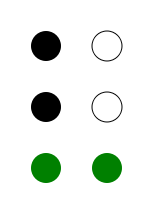Hi (kana)
ひ, in hiragana, or ヒ in katakana, is one of the Japanese kana, which each represent one mora. Both can be written in two strokes, sometimes one for hiragana, and both are phonemically /hi/ although for phonological reasons, the actual pronunciation is [çi] (![]()
| hi | ||||
|---|---|---|---|---|
| ||||
| transliteration | hi | |||
| hiragana origin | 比 | |||
| katakana origin | 比 | |||
| spelling kana | 飛行機のヒ Hikōki no "hi" | |||
| unicode | U+3072, U+30D2 | |||
| braille |  | |||
| kana gojūon | ||||||||||||||||||||||||||||||||||||||||||||||||||
|---|---|---|---|---|---|---|---|---|---|---|---|---|---|---|---|---|---|---|---|---|---|---|---|---|---|---|---|---|---|---|---|---|---|---|---|---|---|---|---|---|---|---|---|---|---|---|---|---|---|---|
|
||||||||||||||||||||||||||||||||||||||||||||||||||
In the Sakhalin dialect of the Ainu language, ヒ can be written as small ㇶ to represent a final h sound after an i sound (イㇶ ih). Along with other extended katakana, this was developed to represent sounds in Ainu that are not present in standard Japanese katakana.
| Form | Rōmaji | Hiragana | Katakana | Example words (with kanji) |
|---|---|---|---|---|
| Normal h- (は行 ha-gyō) |
Hi | ひ | ヒ |
|
| hii hī |
ひい, ひぃ ひー |
ヒイ, ヒィ ヒー | ||
| Addition yōon hy- (ひゃ行 hya-gyō) |
hya | ひゃ | ヒャ |
|
| hyaa hyā |
ひゃあ ひゃー |
ヒャア ヒャー | ||
| hyu | ひゅ | ヒュ |
| |
| hyuu hyū |
ひゅう ひゅー |
ヒュウ ヒュー | ||
| hyo | ひょ | ヒョ |
| |
| hyou hyoo hyō, hyoh |
ひょう ひょお ひょー |
ヒョウ ヒョオ ヒョー | ||
| Addition dakuten b- (ば行 ba-gyō) |
Bi | び | ビ |
|
| bii bī |
びい, びぃ びー |
ビイ, ビィ ビー | ||
| Addition yōon and dakuten by- (びゃ行 bya-gyō) |
bya | びゃ | ビャ |
|
| byaa byā |
びゃあ びゃー |
ビャア ビャー | ||
| byu | びゅ | ビュ |
| |
| byuu byū |
びゅう びゅー |
ビュウ ビュー | ||
| byo | びょ | ビョ |
| |
| byou byoo byō, byoh |
びょう びょお びょー |
ビョウ ビョオ ビョー | ||
| Addition handakuten p- (ぱ行 pa-gyō) |
Pi | ぴ | ピ |
|
| pii pī |
ぴい, ぴぃ ぴー |
ピイ, ピィ ピー | ||
| Addition yōon and handakuten py- (ぴゃ行 pya-gyō) |
pya | ぴゃ | ピャ |
|
| pyaa pyā |
ぴゃあ ぴゃー |
ピャア ピャー | ||
| pyu | ぴゅ | ピュ |
| |
| pyuu pyū |
ぴゅう ぴゅー |
ピュウ ピュー | ||
| pyo | ぴょ | ピョ |
| |
| pyou pyoo pyō, pyoh |
ぴょう ぴょお ぴょー |
ピョウ ピョオ ピョー |
| Other additional forms | ||||||||||||||||||||||||||||||||||||||||||||||||||||||||
|---|---|---|---|---|---|---|---|---|---|---|---|---|---|---|---|---|---|---|---|---|---|---|---|---|---|---|---|---|---|---|---|---|---|---|---|---|---|---|---|---|---|---|---|---|---|---|---|---|---|---|---|---|---|---|---|---|
|
|
| ||||||||||||||||||||||||||||||||||||||||||||||||||||||
Stroke order
 Stroke order in writing ひ |
 Stroke order in writing ヒ |

Stroke order in writing ひ
Other communicative representations
| Japanese radiotelephony alphabet | Wabun code |
| 飛行機のヒ Hikōki no "Hi" |
|
|
 |
 | |
| Japanese Navy Signal Flag | Japanese semaphore | Japanese manual syllabary (fingerspelling) | Braille dots-1236 Japanese Braille |
- Full Braille representation
| ひ / ヒ in Japanese Braille | H/B/P + Yōon braille | ||||||||||
|---|---|---|---|---|---|---|---|---|---|---|---|
| ひ / ヒ hi | び / ビ bi | ぴ / ピ pi | ひい / ヒー hī | びい / ビー bī | ぴい / ピー pī | ひゃ / ヒャ hya | びゃ / ビャ bya | ぴゃ / ピャ pya | ひゃあ / ヒャー hyā | びゃあ / ビャー byā | ぴゃあ / ピャー pyā |
| H/B/P + Yōon braille | |||||||||||
| ひゅ / ヒュ hyu | びゅ / ビュ byu | ぴゅ / ピュ pyu | ひゅう / ヒュー hyū | びゅう / ビュー byū | ぴゅう / ピュー pyū | ひょ / ヒョ hyo | びょ / ビョ byo | ぴょ / ピョ pyo | ひょう / ヒョー hyō | びょう / ビョー byō | ぴょう / ピョー pyō |
| Preview | ひ | ヒ | ヒ | ㇶ | ||||
|---|---|---|---|---|---|---|---|---|
| Unicode name | HIRAGANA LETTER HI | KATAKANA LETTER HI | HALFWIDTH KATAKANA LETTER HI | KATAKANA LETTER SMALL HI | ||||
| Encodings | decimal | hex | decimal | hex | decimal | hex | decimal | hex |
| Unicode | 12402 | U+3072 | 12498 | U+30D2 | 65419 | U+FF8B | 12790 | U+31F6 |
| UTF-8 | 227 129 178 | E3 81 B2 | 227 131 146 | E3 83 92 | 239 190 139 | EF BE 8B | 227 135 182 | E3 87 B6 |
| Numeric character reference | ひ | ひ | ヒ | ヒ | ヒ | ヒ | ㇶ | ㇶ |
| Shift JIS (plain)[1] | 130 208 | 82 D0 | 131 113 | 83 71 | 203 | CB | ||
| Shift JIS-2004[2] | 130 208 | 82 D0 | 131 113 | 83 71 | 203 | CB | 131 242 | 83 F2 |
| EUC-JP (plain)[3] | 164 210 | A4 D2 | 165 210 | A5 D2 | 142 203 | 8E CB | ||
| EUC-JIS-2004[4] | 164 210 | A4 D2 | 165 210 | A5 D2 | 142 203 | 8E CB | 166 244 | A6 F4 |
| GB 18030[5] | 164 210 | A4 D2 | 165 210 | A5 D2 | 132 49 153 57 | 84 31 99 39 | 129 57 189 48 | 81 39 BD 30 |
| EUC-KR[6] / UHC[7] | 170 210 | AA D2 | 171 210 | AB D2 | ||||
| Big5 (non-ETEN kana)[8] | 198 214 | C6 D6 | 199 106 | C7 6A | ||||
| Big5 (ETEN / HKSCS)[9] | 199 89 | C7 59 | 199 206 | C7 CE | ||||
| Preview | び | ビ | ぴ | ピ | ||||
|---|---|---|---|---|---|---|---|---|
| Unicode name | HIRAGANA LETTER BI | KATAKANA LETTER BI | HIRAGANA LETTER PI | KATAKANA LETTER PI | ||||
| Encodings | decimal | hex | decimal | hex | decimal | hex | decimal | hex |
| Unicode | 12403 | U+3073 | 12499 | U+30D3 | 12404 | U+3074 | 12500 | U+30D4 |
| UTF-8 | 227 129 179 | E3 81 B3 | 227 131 147 | E3 83 93 | 227 129 180 | E3 81 B4 | 227 131 148 | E3 83 94 |
| Numeric character reference | び | び | ビ | ビ | ぴ | ぴ | ピ | ピ |
| Shift JIS[1] | 130 209 | 82 D1 | 131 114 | 83 72 | 130 210 | 82 D2 | 131 115 | 83 73 |
| EUC-JP[3] | 164 211 | A4 D3 | 165 211 | A5 D3 | 164 212 | A4 D4 | 165 212 | A5 D4 |
| GB 18030[5] | 164 211 | A4 D3 | 165 211 | A5 D3 | 164 212 | A4 D4 | 165 212 | A5 D4 |
| EUC-KR[6] / UHC[7] | 170 211 | AA D3 | 171 211 | AB D3 | 170 212 | AA D4 | 171 212 | AB D4 |
| Big5 (non-ETEN kana)[8] | 198 215 | C6 D7 | 199 107 | C7 6B | 198 216 | C6 D8 | 199 108 | C7 6C |
| Big5 (ETEN / HKSCS)[9] | 199 90 | C7 5A | 199 207 | C7 CF | 199 91 | C7 5B | 199 208 | C7 D0 |
gollark: It doesn't matter. What I'm trying to get at here is that I don't see why you privilege the actual point at which an egg becomes fertilized that much, if your argument is just about potential to become another thing, since almost identical potential exists immediately before that.
gollark: Again, why? Before an egg is fertilized, there must necessarily exist some point at which it wasn't yet but that was likely to happen soon.
gollark: Does that matter? They're still ultimately quite likely to produce a zygote and then quite likely to produce a fetus and whatever else after that.
gollark: Yes.
gollark: Probably wouldn't work very well otherwise.
References
| Look up ひ, び, or ぴ in Wiktionary, the free dictionary. |
| Look up ヒ, ビ, or ピ in Wiktionary, the free dictionary. |
- Unicode Consortium (2015-12-02) [1994-03-08]. "Shift-JIS to Unicode".
- Project X0213 (2009-05-03). "Shift_JIS-2004 (JIS X 0213:2004 Appendix 1) vs Unicode mapping table".
- Unicode Consortium; IBM. "EUC-JP-2007". International Components for Unicode.
- Project X0213 (2009-05-03). "EUC-JIS-2004 (JIS X 0213:2004 Appendix 3) vs Unicode mapping table".
- Standardization Administration of China (SAC) (2005-11-18). GB 18030-2005: Information Technology—Chinese coded character set.
- Unicode Consortium; IBM. "IBM-970". International Components for Unicode.
- Steele, Shawn (2000). "cp949 to Unicode table". Microsoft / Unicode Consortium.
- Unicode Consortium (2015-12-02) [1994-02-11]. "BIG5 to Unicode table (complete)".
- van Kesteren, Anne. "big5". Encoding Standard. WHATWG.
This article is issued from Wikipedia. The text is licensed under Creative Commons - Attribution - Sharealike. Additional terms may apply for the media files.


